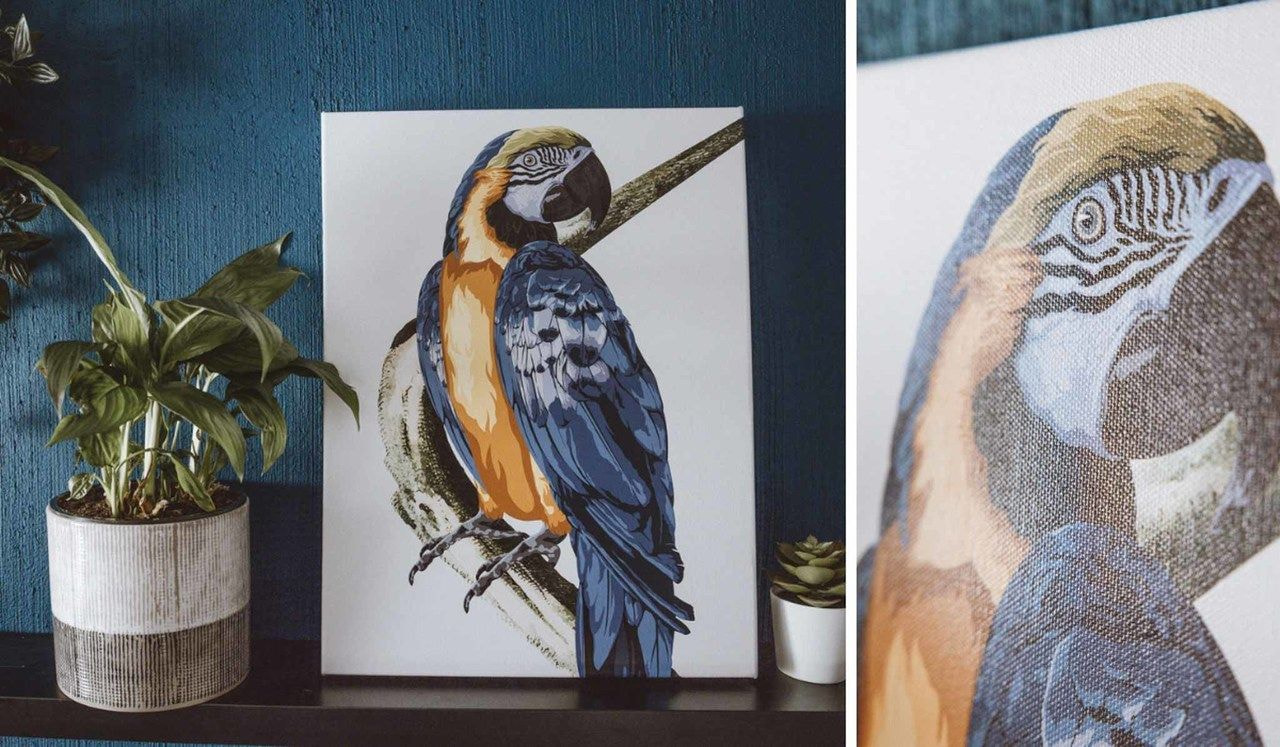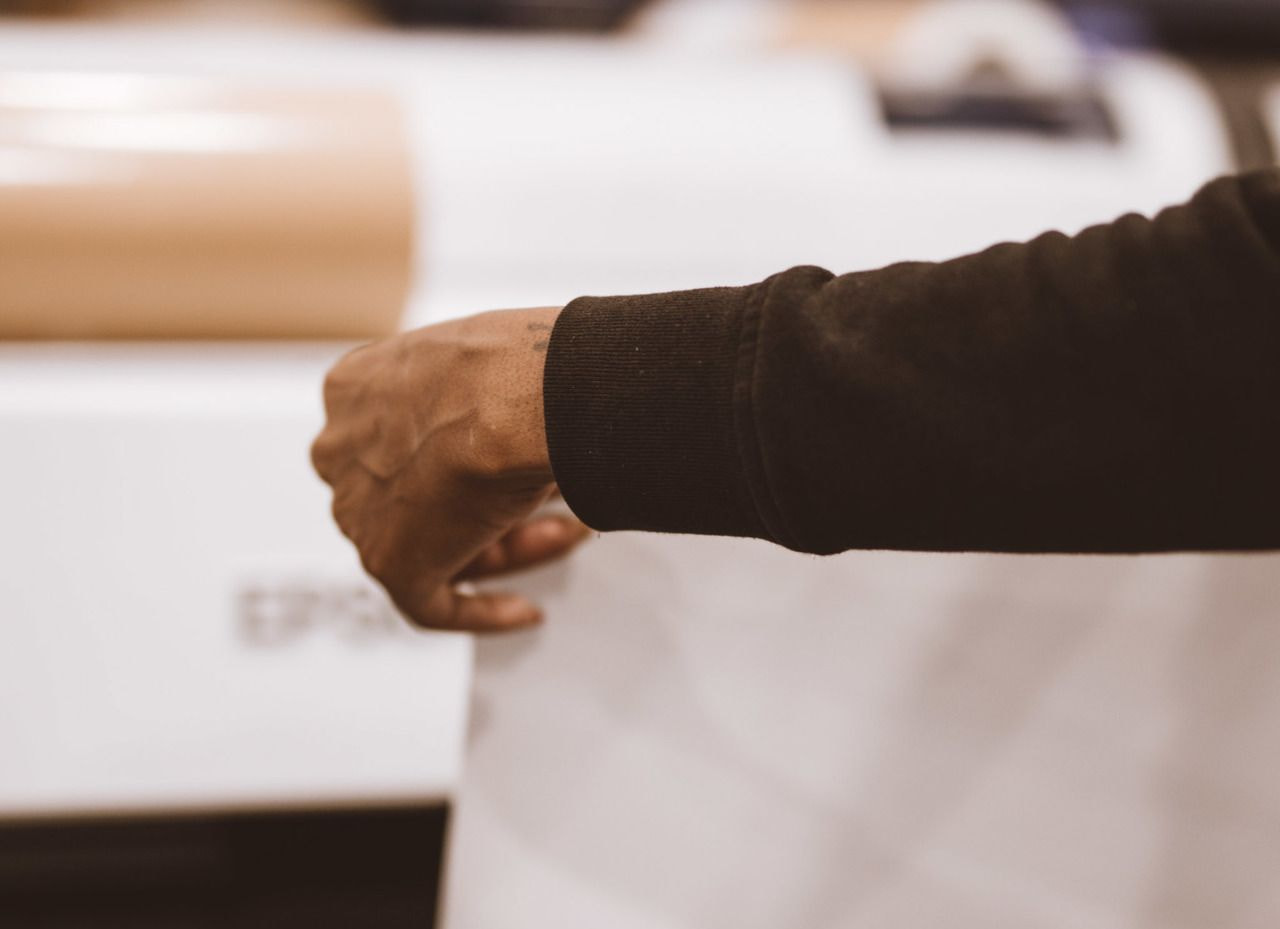[ad_1]
I’m sorry, g-what now? If you’re unfamiliar with the word, don’t worry, you’re not alone. A lot of people are confused about this unusual fine arts term. But you’re in luck because I’m here to tell you all about it. We’ll cover:
-
What a giclée print is
-
How it’s different from other high-quality prints
-
How to use giclée printing
By the end of this blog, you’ll be able to do more than just sneak the term into conversation and know exactly what you’re talking about. You’ll also learn how to use it as part of your ecommerce business and make money from your art.
What is a giclée print?
Giclée is a type of fine arts print. The word is pronounced “zhee’clay” and it comes from the french term “gicleur,” which means “to spray.” This is a nod to the specifics of giclée—in the printing process, an inkjet printer sprays the ink onto paper or canvas. As a result, you get high-resolution 2-D art replicas.
So, does that mean that any inkjet or digital print of an art piece is a giclée print? Not exactly. Your art prints have to meet certain standards to be called giclée. Let’s see what the criteria are.
Giclée prints vs. digital prints: what’s the difference?
When buying giclée prints, customers expect artwork that’s higher quality than a regular poster. So what do you need to qualify as a giclée?
High resolution

Source: Printful
For giclée prints, your image resolution has to be a minimum of 300 DPI.
To start, the resolution level is measured by dots per inch (DPI). What’s DPI? It’s the density of the many little dots that make up your print. Similar to how when you zoom in on a photo and start seeing little pixels. The more DPI, the higher your image resolution—the print will be sharper and more detailed, even up close.
Quality equipment

Source: Printful
Giclée prints require inkjet printers and pigment-based inks only.
Another factor that separates giclées from digital prints: the type of printers and ink. For giclée printing, you don’t use a standard desktop inkjet printer. To produce giclée prints, the printer must be a wide-format inkjet printer.
Giclée prints are also known for their longer lifespan—they’re resistant to smudging, sun, or humidity damage. This deterioration is prevented by using pigment-based instead of dye-based inks. Pigment inks, unlike dye inks, are UV-resistant and stronger when prints are handled.
Archival paper

Source: Printful
Giclée prints require archival quality, with a 100% acid-free base.
Let’s say you can get your hands on top-tier printing technology and pigment inks. Great! But without the right base, the results might be a letdown.
Giclée prints are made with archival paper or canvas. Archival paper is known for its outstanding durability because it’s acid-free. This type of paper or canvas ensures that your prints won’t degrade like regular paper.

Source: Printful
So what’s with all the fuss about fancy inks, printers, and paper? Well, imagine you take a nice photo while traveling with your family. You really like it so you decide to print it. Not wanting to spend money or wait, you use your home printer instead of ordering professional prints.
You hang the photo on a wall and call it a day. Unfortunately, in a few weeks, your printout will see some wear and tear from sunlight and room humidity. Or maybe there was some wet ink left and you accidentally streaked or smudged it while handling it.
You might not notice these imperfections in printed documents with just text. But for paintings and art photography with lots of color and details, any flaw will be an eyesore.
Giclée printing at Printful

Source: Printful
For wall art products we use inks that are highly scratch-resistant, providing that giclée standard resistance to wear and tear. We print with high-quality Epson inkjet printers which will guarantee you precise details and smudge-free prints.
Our products also go through a 3-step quality check to make sure you get exactly what you wanted:
-
Before printing: we review your print file to see if it’s good enough for printing
-
During printing: we keep an eye on the process to avoid any smudges, misplacement, and color issues
-
After printing: we do a final check and compare it to your design file
So if you’re ready to consider Printful as your giclée printer, check out what we’ve got in store for you.
Printing options
For art prints we offer four types: posters, framed posters, canvas, and framed canvas. Here’s a quick walkthrough to help you choose the right one for your business.
Posters
The regular and framed posters are the same, except for, obviously, the frame.
We recommend selling both framed and unframed posters. The framed ones offer an easy purchase for customers who want to quickly get an art piece that’s ready to use. Just order it and hang it up straight away.
The unframed ones, while obviously cheaper, are great for picky customers. They’re usually the ones who want to choose a fancier frame themselves or they already have it at home as part of their collection.
Canvas
This is the best option for painting reproductions. The rough texture of a canvas in combination with your artwork will imitate the brushstroke effect.
This wall art category also comes with framed and unframed options. Same as with posters, we recommend offering both to your customers.


@media (max-width:768px)
.pf-btn-lg height: 40px; line-height: 38px; min-width: 88px; font-size: 16px;
Giclée print file guidelines for the best results
High-tech equipment is important to ensure the quality of a giclée print. But all the printers in the world won’t give you that museum-quality art you’re looking for if you don’t have a good print file to start off with.
Let’s go over the main things you need to remember to get the ideal giclée print file.
1. Use high-resolution images
Giclée printing requires high-res images to produce the best quality prints. As I mentioned earlier, go for at least 300 DPI. This ensures that your prints will look impeccable both from afar and up close with a magnifying glass.
2. Create files in sRGB color profile
A giclée print is a replica of your original work. So it’d be pretty bad if what’s printed doesn’t look the same as what you saw on your screen. Whether it’s a photo, scan, or digital artwork, make sure your color profile is set to sRGB.
That’s because our printers use a lot of different color shades that fall outside the range of other color profiles (like CMYK). The sRGB color profile will provide the most accurate print results.
Read more: Color Matching Guide for Print-on-Demand Products
3. Check for bleeds and template guidelines
Bleeds are an extra inch or so of the image that extends beyond the trim of the print. If your giclée print has elements that line the edge of the page, you’ll need to include bleeds in your file. This ensures that there are no white borders around the edges of the print when it’s trimmed down to size.
As for template guidelines—this is only necessary if you use our file templates found on product pages. They’re great for creating the exact print size necessary. Just remember to remove the guidelines from your print file before exporting it. Otherwise, they’ll be printed as well. Unless a rough, unfinished look is a style choice, you don’t want that to happen.
Following these tips will help you create a print file you can reuse not just for giclée prints but also for printed apparel, accessories, and home & living products.
Where and how to sell giclée prints online
You can sell giclée prints either on your website or an online marketplace. To build a standalone website—an online store—use ecommerce platforms like Shopify or Squarespace. These platforms have premade store templates, add-ons for extra features and analytics, and more perks. Keep in mind, platforms normally have a monthly fee (about $30, on average).

Source: Scott Erickson Art Shop
Having a storefront on a marketplace is cheaper, but not free. Usually, these marketplaces will charge a small commission per order or product. The storefront is also less customizable than on an ecommerce platform.

Source: ArtsavesJulia, Etsy
Which to choose? Depends on what you’re looking for. If you want a highly customizable store that’s all your own, pick platforms. If you want to access an established audience of art collectors, pick a marketplace like Etsy.
Selling giclée prints with Printful
Whichever store option you choose, you can sell giclée prints on demand with Printful. And it all takes just a few steps:
-
Sign up to Printful
-
Connect your store via our ecommerce integrations
-
Pick a wall art product in our catalog
-
Add your artwork to it
-
Sell it on your store
You won’t have to pay upfront for the posters, canvas, or any other products. We’ll only charge you for the items you sell + shipping.


@media (max-width:768px)
.pf-btn-lg height: 40px; line-height: 38px; min-width: 88px; font-size: 16px;
Time to kick(st)art your giclée business
And that’s all you need to know about the now not-so-mysterious giclée. I hope this article clarified the details of giclée standards, requirements, and selling them online.
Paintings, photographs, sketches, or other original artwork, giclée prints are a great way to monetize your hobby. With this technique, art lovers around the world can support your passion and have your original piece adorn their homes.
Let us know in the comments if you’ve ever tried selling art prints and how’s it going!
[ad_2]
Source link









